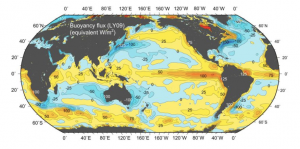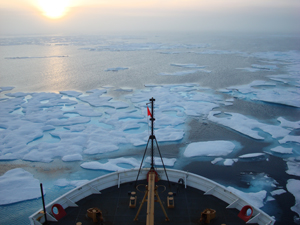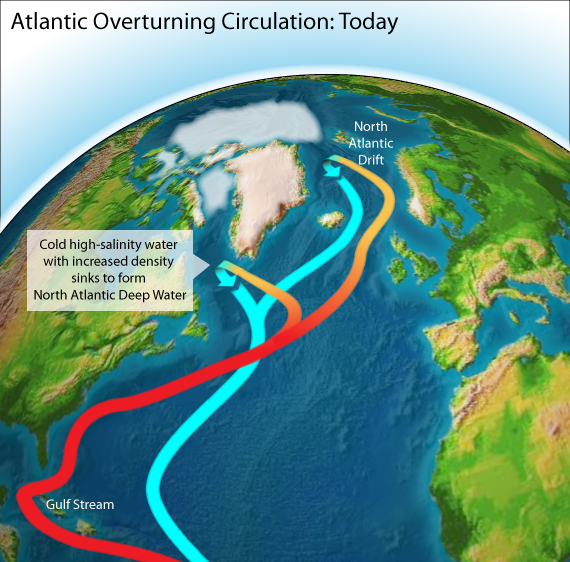Source: Newsom, E. R., and A. F. Thompson (2018), Reassessing the role of the Indo-Pacific in the ocean’s global overturning circulation. Geophysical Research Letters, doi:10.1029/2018GL080350.
Water is transported around the world’s oceans via a current system called the global overturning circulation (GOC), often referred to as the great ocean conveyer belt. Figure 1 below shows the approximate path of this conveyer belt–red indicates transport near the surface and blue represents deep transport. Along with water, these currents carry and redistribute heat, salt, and gasses. Therefore, the overturning circulation plays an important role in regulating the global climate system.
The GOC pathways shown in Figure 1 are controlled, in part, by changes in the density of the surface ocean–called surface buoyancy fluxes. The density of seawater depends on its temperature and salinity (the amount of salt in it). Therefore, surface buoyancy fluxes are related to changes in the heating or cooling of the surface ocean, as well as changes in the salt content due to precipitation, evaporation, and ice processes.
For example, consider the sinking of waters in the North Atlantic signified by the red-to-blue arrows off Greenland in the diagram. This deep water formation is due to the rapid cooling of surface waters as they flow into the Arctic (making it denser). Water also sinks in the Antarctic because of sea ice formation. As water freezes, salt is removed and ends up in the surface water (making it denser). In other words, sinking of waters in the polar regions due to surface buoyancy fluxes is known to have a significant influence on the GOC. It is generally assumed however, that surface processes in the Indian and Pacific Oceans (collectively called the Indo-Pacific) are not as important as in the polar regions.

In a recent study published in Geophysical Research Letters, scientists at Caltech challenged this assumption that surface buoyancy fluxes in the Indo-Pacific are less important to the GOC than surface processes in the polar regions. This conclusion is reached through examination of buoyancy transport in a coupled climate model. The scientists developed a new technique that uses the patterns of surface buoyancy flux to infer the circulation in the ocean interior.
The map in Figure 2 shows the surface buoyancy flux in the global ocean. Note that the equatorial Pacific is the most orange, meaning that it has the highest positive buoyancy flux (surface ocean becomes lighter). The north Atlantic on the other hand is blue, meaning that it has negative buoyancy flux (surface ocean becomes denser). The GOC must act to counter this imbalance, transporting buoyancy from where it is gained at the surface (equatorial Indo-Pacific) to where it is lost (North Atlantic). This reinforces the importance of the GOC in linking the different ocean basins. The scientists also argue that this means the structure of the GOC depends equally on surface processes in the equatorial Indo-Pacific and in the polar regions.

It may seem like a small and unimportant detail that the global overturning circulation is driven by surface processes in the low-latitudes of the Indo-Pacific and the polar regions (as opposed to just in the polar regions as was previously assumed). But this result could have significant implications for global climate, namely that it may depend more on surface buoyancy fluxes in the Indo-Pacific than is usually assumed. Scientists are still working to understand the processes that drive this global system. The results from this study help reframe the way we think about the controls on the GOC. Accurately describing these processes is important because changes in the circulation affect the rate of heat and carbon uptake by the ocean.
I’m a physical oceanography PhD student at Scripps Institution of Oceanography in La Jolla, California. I use a combination of numerical models, observations, and remote sensing to investigate the role of the ocean in climate. I’m particularly interested in Southern Ocean dynamics, including air-sea-ice interactions and physical controls on biogeochemistry.



